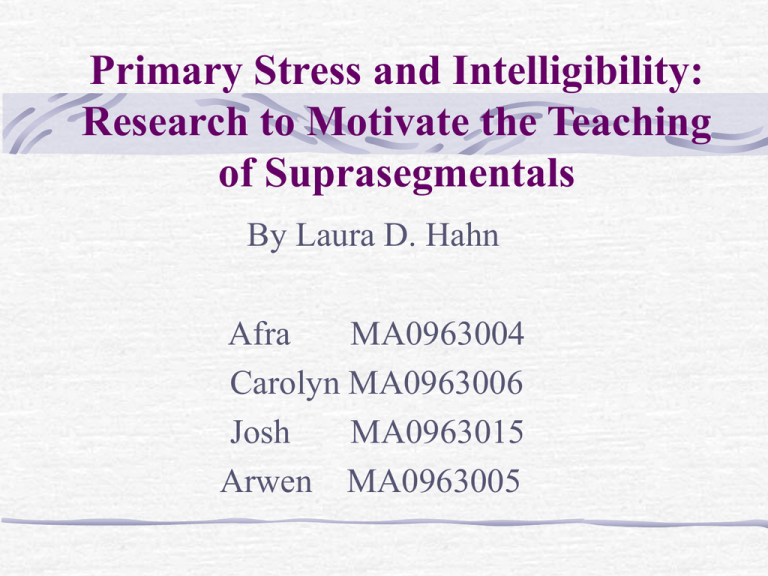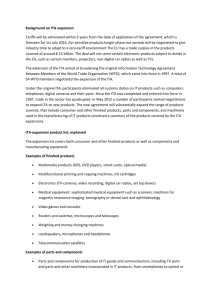PPT
advertisement

Primary Stress and Intelligibility: Research to Motivate the Teaching of Suprasegmentals By Laura D. Hahn Afra MA0963004 Carolyn MA0963006 Josh MA0963015 Arwen MA0963005 Introduction The relationship of the primary stress and intelligibility motivates The teaching of suprasegmentals What is the Suprasegmental? Stress Intonation Timing Rhythm juncture The Purpose of This Study Whether the correct placed primary stress affects the processing, comprehension, and evaluations of the native speak listeners Background knowledge 1.Teaching the NNS suprasegmentals does improve the intelligibility of their speech. 2. Isolated primary stress ※NNS means the nonnative speakers How to realize the primary stress By combining a detectable change in pitch with increased vowel duration and intensity Example: A: Are you ready? B: I’m always ready. The GNSC (Given-new stress connection): new and contrastive information is presented in stressed elements, and old or given information is expressed in unstressed elements. The Chinese learners’use the primary stress Chinese learners used pitch movement of every word in a message unit. Example: Correct 1 2 Wrong 1 1 Living room→ Living room Book store → Book store Two Problems 1.Misplacing primary stress 2.Stressing all words Method An experimental study was designed using oral texts constructed to systematically vary the GNSC. Subjects 90 subjects, 30 each to 3 experimental groups They are first-semester freshman students, come from Midwestern public university and speak North American English Materials Three versions of a text recording by a Korean. Digital editing techniques make sure these three versions equal, including volume and length (4.5 minutes). Three versions Version A: GNSC was maintained. Version B: GNSC was violated through misplaced primary stress. Version C: GNSC was violated through absence of primary stress. The main purpose 1. Measure of Difficulty Processing Discourse * Dual-task paradigm * The participants’ primary task was A. to understand and remember the lecture’s content B. to monitor for a tone presented in the background of the speech 2. Measure of Comprehension * The study measured in two ways (1)subjects were asked to write down as much as they could recall from the lecture (2)a short-answer comprehension quiz * The questions elicited each main idea in the lecture. 3. Measure of Evaluative Reactions to the Speaker * Instructor and Course Evaluation System (ICES) Item Catalog: use to collect feedback from students on their classroom instruction. Procedure 30 30 30 First, the researcher explained the instructions and the format of the experiment. Second, specific instructions and practice for the reaction time task were provided on the computer. Third, the subjects were then informed that they would be listening to a TA and were then asked to complete the reaction time task, the recall, the quiz, and the ICES ratings in that order. RESULTS As shown in the following Table: 3 Discussion This consistent pattern in the results supports the general proposition that correct primary stress in extended nonnative discourse facilitates communication. Implications for ITA programs and curricula It therefore seems logical that the ITA curriculum should include instruction in primary stress. A broad perspective that acknowledges the various roles that pronunciation features play in communicating meaning in discourse would enhance ITA programs and materials. Implications for pronunciation pedagogy and materials Fortunately, primary stress can be learned, primary stress is both teachable and valuable for communicating. Conclusion This research provides evidence that primary stress contributes significantly to the intelligibility of nonnative discourse, and it strengthens the broadly stated claims in the pedagogical literature on ESL pronunciation that teaching suprasegmentals is important.











